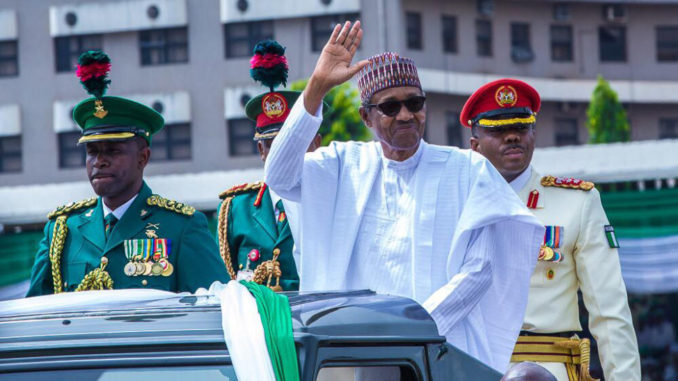
Not ones to waste an opportunity, the supporters of the President, Maj.-Gen. Muhammadu Buhari (retd.), are in a jubilant mood that Nigeria has once again overtaken South Africa as Africa’s largest economy. Bloomberg – a global financial data organisation –triggered their ecstasy after it released its rating on the economies in Africa. Noting that South Africa had fallen into another recession within two years, it ranked Nigeria as the continent’s biggest economy. Further, Bloomberg predicted that, in 2020, growth would recede in South Africa, while Nigeria would grow faster, causing celebration for some groups in the country. With the realities on the ground, their smugness is misguided.
For Nigeria, the meat of the matter is the thing left unsaid. As large as it is, its economy is extremely vulnerable because it is rabidly dependent on oil revenue. It experienced recession in 2016 when oil prices crashed in mid-2014. With Saudi Arabia and Russia facing off over the coronavirus pandemic, it should brace for more shocks in 2020. Oil lost 20 per cent on Monday, crashing to $35.51 per barrel. The benchmark of the 2020 budget is $57pb; Goldman Sachs, the global investment bank, is predicting $20 per barrel soon.
Beyond this, the real numbers from the Bloomberg report paper over the cracks for Nigeria. South Africa’s Gross Domestic Product deflated by 1.4 per cent in third quarter 2019, reducing the size of that country’s economy to $352 billion, Statistics South Africa stated. In turn, Nigeria witnessed a 2.55 per cent growth in Q4 2019. Not only did that beat the forecasts, it was the highest growth in a quarter since the recession of 2016, and gave Nigeria the advantage of ending 2019 with a GDP of $476 billion (parallel rate of N306 per $1) or $402 billion (official rate of N360 per $1).
Tracing South Africa’s downturn essentially to power cuts, which affected production and investor confidence, the report attributed the boost in Nigeria’s GDP to expansion of credit and output. But the South African economy is more sophisticated than Nigeria’s, with an installed capacity to generate 51,309 megawatts of electricity. Conversely, Nigeria’s output oscillates between 3,000MW and 5,000MW. That is too dismal to drive productive activities.
It highlights this logic: production is at a pedestrian level in Nigeria. As of July 2019, industrial output was negative at -2.19 per cent, the Central Bank of Nigeria stated. To make up, the country has become dependent on imports, ridiculously importing refined petroleum products, electronics, drugs, palm oil and food items. In its latest Foreign Trade in Goods Statistics report, the National Bureau of Statistics stated that Nigeria recorded its first quarterly trade deficit since July 2016 as the value of its exports fell by 9.79 per cent in Q4 2019 and imports rose by 37.20 per cent.
Not surprisingly, global ratings agencies are downgrading the outlook on Nigeria. In February, Moody’s demoted Nigeria’s credit rating from B to negative. Standard and Poor’s had earlier revised the outlook from stable to negative. This means the economy is fragile and low on investor confidence.
On the macro level, a calamity is in the offing. In 2018, the World Poverty Clock adjudged Nigeria as the global capital of the world with 86.9 million of the population living below the $1.50 per day threshold. Instead of subsiding as it has occurred in India, China and Brazil, the number of extremely poor Nigerians has ballooned to 94 million, an indication of the dysfunction in the economy.
With modest production going on, the level of unemployment has attained a catastrophe. Data from the NBS state a 23.1 per cent jobless rate. Underemployment stands at 20.1 per cent. With thousands graduating annually and having no jobs, the youth unemployment/underemployment rate is at 55.4 per cent. This speaks volumes.
The grim numbers are complicated by the population. At 2.6 per cent, it is soaring faster than the 2.27 per cent GDP growth rate Nigeria recorded in 2019. Nigeria’s population is expected to hit 206 million at the end of 2020. This is 2.64 per cent of the total world population, ranking it seventh globally. At this rate, Nigeria is projected to become the third most populous country in the world by 2050 – 30 years away – after India and China, overtaking the United States, the United Nations’ World Population Prospects 2017 stated. Worse, the negative impact of these numbers has yet to prompt the Buhari regime into meaningful policy initiatives. South Africa, with 58.8 million citizens and a GDP of $352 billion, is at a much better advantage than Nigeria.
Furthermore, the inflation rate in Africa’s largest economy is unforgiving. It is currently 12.13 per cent. It makes planning double difficult and reduces the quality of money. It is far higher than South Africa’s rate of 4.5 per cent reported by Stat SA in January. The exchange rate here is anti-growth. At the official rate of N306 to US$1 and N360 to $1 at the parallel market, the currency is far weaker than South Africa’s which exchanges at 14.43 rand to US$1. The CBN benchmark interest in Nigeria is at 13.5 per cent. It goes as high as 33 per cent for borrowers. This is a disincentive to investment. In comparison, South Africa has 6.5 per cent.
To sustain its economy and reduce poverty, Nigeria should redirect its policies. In this, privatisation, which has been practically abandoned by the Buhari regime, should be promoted in all spheres of national life. Under the late Prime Minister, Margaret Thatcher, the United Kingdom privatised key public assets such as the railways, aviation, banking and power. This lifted the economy substantially.
With its tax-to-GDP currently around six per cent – one of the lowest in the world – the regime should increase its capacity to collect non-oil revenue, using the windfall to build infrastructure, education and health services.
END

Be the first to comment